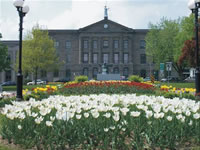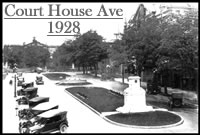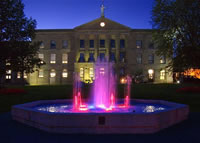
Brockville
is located in the Thousand Islands region on the St. Lawrence River in Leeds
& Grenville County, Eastern Ontario, Canada.
Known as the "City of the 1000 Islands", Brockville is located on the north
shore of the St. Lawrence River, directly opposite Morristown, New York,
about half-way between Cornwall in the east and Kingston in the west and a
little over an hour's drive south of the nation's capital, Ottawa.
Brockville is one of the oldest cities in Ontario and is named after the
British general Sir Isaac Brock.
This area of Ontario was first settled in 1785 by hundreds of American
refugees who later became known as United Empire Loyalists for their
political position on the side of King George III during the American War of
Independence. This struggle between Britain and the 13 American colonies
took place in the years 1776 to 1783 and seriously divided loyalties in some
colonies such as New York and Vermont. During the 6-year war, which ended
with the capitulation of the British forces in 1782, many of those colonists
who remained loyal to the crown were frequently subject to harsh reprisals
and unfair dispossession of property. Many "Loyalists" chose to flee north
to the then British colony of Quebec. Later this western region of Canada
was opened and settled by English-speaking refugees of the past American
war. The St. Lawrence River, which flows between Brockville and Morristown,
New York, was named by French explorers in the 1700s to commemorate the
martyred Roman Christian, Saint Laurentis. The small inlet on the north
shore of the St. Lawrence River had been a natural resting point for French
voyageurs in the past. In 1785 the first U.E. Loyalist to take up land here
on the site of Brockville was a disbanded ensign with the King's Rangers
from the state of New York, William Buell Sr. (1751-1832). The initial
settlement on this site was commonly referred to as "Buell's Bay". Around
1810 the village was designated as Elizabethtown by government officials of
Upper Canada. Leading residents of the small village decided, about 1812,
that it might be appropriate to suggest a name which differed from the
surrounding township of Elizabethtown.

This was during the ensuing second war with Canada's American neighbours,
known as the War of 1812. The commanding ranking British General in Upper
Canada and the temporary administrator of the province was Major-General
Isaac Brock who was celebrated as the "Hero and Saviour" of Upper Canada
because of his recent success in securing the surrender of Fort Detroit.
Perhaps to curry favour with Gen Brock, certain leading citizens in the
village including Charles Jones, proposed the name of Brockville and began
using this new name in their correspondence and dealings with Isaac Brock
who was also the civil administrator of the province. Gen. Brock was soon
involved in other battles on the Niagara Peninsula, and on October 13, 1812,
he was fatally shot while leading his troops up the heights near the village
of Queenston, then being held by American militia. The general had been aware
of the honour being offered by the residents of Elizabethtown but may have
been unable to give it his official blessing before his death. The new name
was later accepted by the provincial bureaucrats and soon became commonly
used by residents and visitors. In 1830 the growing population of Brockville
had managed to exceed the 1000 mark. This entitled it to be represented by
its own elected member in the House of Assembly, and Henry Jones, the
village postmaster, was elected in October 1830 to the 11th Parliament of
the Province. Brockville became Ontario's first incorporated self-governing
town on January 28, 1832, two years before the town of Toronto. By means of
the Brockville Police Act, passed by the Legislative Assembly of Upper
Canada, Brockville was given the right to govern its own affairs, pass laws
and raise taxes. The first elections for the new Board of Police were held
on April 2, 1832 to choose 4 members to the Board. These four in turn chose
a fifth member, Daniel Jones, who was also chosen as the first Police Board
president or Mayor of Brockville. This was the gentleman who in March 1836
became the first native Upper Canadian to receive a royal knighthood from
King William IV, and became "Sir Daniel Jones".

The
town became a local centre of industry including shipbuilding, saddleries,
tanneries, tinsmiths, a foundry, a brewery, and several hotels in the 1800s.
By 1854, a patent medicine industry had sprung up in Brockville and in
bordering Morristown, NY featuring products such as Dr Morse's Indian Root
Pills, Dr. McKenzie's Worm Tablets and later, Dr. Williams' Pink Pills for
Pale People.
The south portal of the Brockville Railway Tunnel, Canada's first railway
tunnel, opened in 1860.
The south portal of the Brockville Railway Tunnel, Canada's first railway
tunnel, opened in 1860.
The CPR caboose or "van" donated to Brockville by the Canadian Pacific
Railway for display. It is located on the waterfront near the tunnel.
The CPR caboose or "van" donated to Brockville by the Canadian Pacific
Railway for display. It is located on the waterfront near the tunnel.
In 1855, Brockville was chosen as a divisional point on the line of the new
Grand Trunk Railway, which was built and opened from Montreal to Toronto. At
the same time, the north-south line of the Brockville & Ottawa Railway was
built as a transportation link to join the St. Lawrence River ship route
with the timber trade of the Ottawa Valley. A well-engineered tunnel for
this railway was dug and blasted underneath the middle of Brockville from
1854 to 1860. This was the first railway tunnel of its kind created and
opened in Canada, and remains in place for visitors to enter and experience.
Brockville and many other towns in Canada West became involved in the
threatened Fenian invasion following the close of the American Civil War in
1865. In June 1866, the Irish-American "Brotherhood of Fenians" invaded
Canada. Raids were launched across the Niagara River into Canada West and
from Vermont into Canada East. Canadian Premier John A. Macdonald called on
all the volunteer militia companies in every town to protect Canada.

The
Brockville Infantry Company and Brockville Rifle Company were mobilized to
protect Brockville. These unsuccessful Fenian Raids were a significant
factor leading to the creation of the new Dominion of Canada in 1867.
Brockville was granted the official status as a City in 1962. Its coat of
arms features a beehive surrounded by a golden chain and bears the motto
Industria, Intelligentia, Prosperitas. This is an official heraldic design.
Brockville is also one of the few cities that has a recognized heraldic
flag.
From Wikipedia

